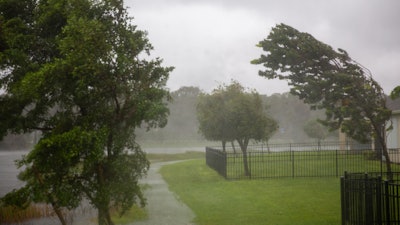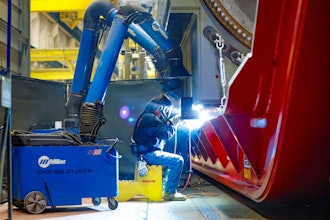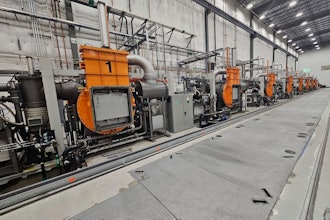
In May, forecasters at the National Oceanic and Atmospheric Administration's National Weather Service predicted an above-average hurricane season, which spans from June 1 to November 30.
As new facilities break ground across the country, business owners must become educated on the risks of hurricanes not only to their site but also to their supply chain.
In this exclusive interview, Jon Meyer, manufacturing segment lead, and Becky Urban, business insurance field vice president of the southern region at New York-based insurance company Travelers, discuss how hurricane risk extends far beyond the coast, how manufacturers can prepare for weather-related disruptions and what to do when you're in the storm's path.
Q: What are the primary long-term areas I should focus on to help reduce my risk during hurricane season?
Becky Urban: If you are in an area that has historically been hurricane-prone, or perhaps has only recently been impacted by a hurricane, and you want to prepare for the possibility of a future hurricane, there are important steps you can take to increase your business's hurricane resistance and mitigate potential risks.
The first area to consider for long-term hurricane preparation planning is the physical property of your business. This includes regularly inspecting roofs, windows, doors, and other areas susceptible to wind damage and water intrusion. Protecting the inside of your business starts with making sure your facilities are well-maintained so you don't have to worry about them as a storm approaches.
Determine whether you need and how you will access emergency power should your business lose power for an extended period. Build inventory lists. Know what products and equipment you have on premises for your business. Keep this up to date as it can come in handy if you must itemize a claim following hurricane damage (or any type of insurance claim for that matter).
Last, but certainly not least, build a short-term plan now. Don't wait for a hurricane to be in your local forecast to prepare for what to do when it arrives. Have the plan in a place where it can be accessed even if you lose power. And make sure your employees understand their responsibilities should the plan need to be enacted. Being prepared will reduce potential stress during an otherwise stressful period with a storm approaching.
Q: My facilities are hundreds of miles inland from the coast. Should I be worried about hurricanes? How could my operations be impacted by a hurricane even if I'm not in an area prone to them?
BU: Hurricane risks extend far beyond immediate coasts that are most prone to them. While a manufacturing facility in the Upper Midwest might not be in danger of a direct hit from a hurricane, some of its suppliers or perhaps the port where its equipment, materials and supplies arrive in the country could certainly be directly impacted.
Additionally, we are seeing stronger storms impact deeper into the country from coastal regions. This means facilities hundreds of miles from the shore could now face disruption that might have otherwise felt safe in the past.
We've also seen different risks associated with hurricanes as they move deeper into the country. For example, inland areas are especially at risk for flooding as storms inundate areas with heavy rain in a short period of time. In an instance like this, manufacturing facilities should consider the following:
- Understand where or how water might build during a flash flooding situation
- Know where to place barriers to divert water away from facilities
- Protect low-lying building entrances and openings
- Don't use basements to store critical materials
- Install shut-off valves on sewer and other drainage lines to prevent reverse flow
- Store water-damageable materials on pallets or on racks where possible
Q: How can I prepare for any severe weather-related disruptions to my supply chain?
Jon Meyer: Becky's point about even inland facilities being vulnerable to disruption from a hurricane highlights how every company should have plans in place for supply chain disruptions from severe weather events.
Manufacturers can take a proactive approach to mitigate severe weather-related disruptions to their supply chains. This starts with conducting a comprehensive risk assessment to identify vulnerabilities, including key suppliers and transportation routes that may be affected by adverse weather conditions. Understanding these risks allows for the development of contingency plans, such as diversifying suppliers, securing alternative transportation methods, and maintaining higher inventory levels of critical components. Collaborating with suppliers and logistics partners to ensure robust emergency plans are in place is crucial for maintaining continuity during any type of disruption.
Building resilience into supply chain infrastructure is also essential. Strengthening physical assets, such as warehouses and production facilities, to withstand severe weather events is a key strategy. Regular training and drills for employees on emergency procedures ensure preparedness and minimize downtime during actual events. By fostering a culture of resilience and adaptability, manufacturers can protect their operations from weather-related disruptions and enhance their overall competitiveness in the market.
Q: Our area is now under threat of a hurricane or tropical storm. What steps should we be taking in the days leading up to the storm's arrival?
BU: It's time to implement the short-term plan. Here are five areas we suggest making sure are part of your short-term plan beyond communicating clearly with your employees:
- If you have vehicles or mobile equipment, move them to the storage facilities you have in case of emergency to protect them from potential damage.
- Contact your vendors to discuss alternatives and pausing deliveries.
- Implement your plan to protect windows and doors.
- Check all exterior signage to make sure it is properly secured and anchored, whether on a roof, wall or mounted elsewhere on the property. Any other equipment and material situated outside your business should also be properly secured.
- Make sure your emergency supplies are fully stocked in a secure location that is not at risk to flood or wind risks.
Q: After the storm has passed, what are the key things to consider during recovery and cleanup?
JM: After a storm, there are several critical steps to ensure a smooth claim process and expedite repairs and rebuilding efforts:
- Inspect your business as soon as it is safe, deploying a recovery team that includes qualified maintenance personnel to assess potential damage.
- Restrict access to facilities to non-essential personnel to minimize the risk of injury.
- Conduct a thorough review of your inventory, including finished products and raw materials, to determine usability.
- Document any damage with photographs and detailed notes, which will be valuable when filing insurance claims.
- If it's safe to do so, use tarps or other protective materials to prevent further damage to your property.
- Establish communication with your insurance carrier or broker/agent to initiate any necessary claims promptly.
Throughout the recovery process, maintain clear communication with employees regarding the status of recovery efforts and expectations for reopening. This helps manage expectations and ensures everyone is informed about the progress and any changes.
Additionally, consider evaluating the effectiveness of your emergency response and recovery plans to identify areas for improvement. This reflection can enhance preparedness for future events, strengthening your overall resilience. By focusing on these key aspects, manufacturers can efficiently navigate the recovery phase and return to normal operations as quickly as possible.






















